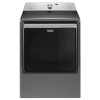Maytag MEDB835DC W10240504 - Page 19
Temperature Levels Incorrect, Timed Dry, IMPORTANT, TIMED DRY
 |
View all Maytag MEDB835DC manuals
Add to My Manuals
Save this manual to your list of manuals |
Page 19 highlights
FOR SERVICE TECHNICIAN'S USE ONLY NOTE: All thermistor resistance measurements must be made while dryer is unplugged and connector removed from ACU. OUTLET THERMISTOR RESISTANCE TEMP. °F (°C) 50° (10°) 60° (16°) 70° (21°) RES. RANGE k ohms 19.0-22.0 14.8-16.8 11.5-13.5 TEMP. °F (°C) 80° (27°) 90° (32°) 100° (38°) RES. RANGE k ohms 8.5-10.5 6.8-8.8 5.0-7.0 If the resistance is OK, the outlet thermistor is good. Proceed to step 4. If the thermistor resistance does not agree with the table, replace the outlet thermistor. 4. Check P14-3 and P14-6 to dryer cabinet ground. If either pin indicates continuity to ground (short), replace wiring harness; otherwise, proceed to step 5. 5. If the preceding steps did not correct the problem, replace the ACU. Temperature Levels Incorrect - If no error code is displayed and the connections to the thermistor are good, check the exhaust temperature value at any or all of the temperature levels in question, using the Timed Dry cycle. IMPORTANT: Be sure EcoBoost or Energy Saver (if available) is turned OFF before testing. 1. Remove load from dryer and disconnect external vent. 2. Plug in dryer or reconnect power. 3. Run a TIMED DRY cycle (Mixed + Timed Dry on Whirlpool models) of at least 2 minutes in duration and select a temperature setting using heat. 4. Using a calibrated temperature probe, take a temperature measurement in the center of the exhaust outlet. The correct exhaust temperatures are as follows: EXHAUST TEMPERATURES TEMPERATURE SETTING (appearance may vary) HEAT TURNS OFF* °F (°C) HEAT TURNS ON °F (°C) 155° ± 5° (68° ± 3°) 140° ± 5° (60° ± 3°) 125° ± 5° (52° ± 3°) 105° ± 5° (41° ± 3°) 10-15° (6-8°) below the heat turn off temperature If the temperature is not reached within ~7 minutes, check voltage level and vent blockage, and then retest. If the temperature probe does not agree with temperature setting, replace the outlet thermistor. If the temperature probe confirms the temperature setting, retest at a different temperature setting. 5. If the preceding steps did not correct the problem, replace the ACU. Inlet Thermistor NOTE: On the electric dryer, the inlet thermistor is part of the high thermostat assembly (see figure 10a). On the gas dryer, the inlet thermistor is located at the drum inlet duct (see figure 16, page 27). The ACU monitors the inlet temperature using the inlet thermistor. The inlet thermistor (along with the outlet thermistor) is used to detect air flow, and assists in calculating load size. 1. Unplug dryer or disconnect power. 2. Remove console to access the machine electronics. 3. Remove connector P14 from the ACU and measure the resistance between P14-1 and P14-2 at the connector. The following tables (electric & gas) give temperatures and their associated resistance values. NOTE: All thermistor resistance measurements must be made while dryer is unplugged and connector removed from ACU. If the resistance is OK, the inlet thermistor is good. Proceed to step 4. If the thermistor resistance does not agree with the table, replace the inlet thermistor. ELECT - INLET THERMISTOR RESISTANCE TEMP. °F (°C) 68° (20°) 77° (25°) 86° (30°) 95° (35°) 104° (40°) 113° (45°) 122° (50°) RES. RANGE k ohms 61.2-63.7 49.0-51.0 39.5-41.1 32.0-33.3 26.1-27.2 21.4-22.3 17.6-18.5 TEMP. °F (°C) 131° (55°) 140° (60°) 149° (65°) 158° (70°) 167° (75°) 176° (80°) RES. RANGE k ohms 14.5-15.3 12.1-12.8 10.2-10.7 8.5-9.0 7.2-7.6 6.1-6.5 GAS - INLET THERMISTOR RESISTANCE TEMP. °F (°C) 68° (20°) 77° (25°) 86° (30°) 95° (35°) 104° (40°) 113° (45°) 122° (50°) RES. RANGE k ohms 57.5-67.6 46.1-53.8 37.4-43.1 30.4-34.7 24.9-28.2 20.5-23.0 16.9-18.9 TEMP. °F (°C) 131° (55°) 140° (60°) 149° (65°) 158° (70°) 167° (75°) 176° (80°) RES. RANGE k ohms 14.1-15.6 11.8-12.9 9.9-10.8 8.4-9.0 7.1-7.6 6.0-6.4 DO NOT REMOVE OR DESTROY PAGE 19















